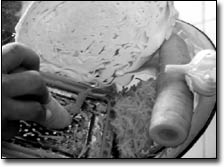
Winter food
by Chef Boy Ari

In winter, my thoughts inevitably turn to Siberia. There are other reasons for this, besides the fact that Siberia is clich`E9d as a place of perpetual winter. Sure, it's cold there, but contrary to Siberia's role for many years as a place of banishment, it's really nice there, too. Lots of clean land and water, lots of really great people, and lots of great things to eat. And that's why my thoughts turn there in winter.
In any Siberian meal, even in the dead of winter, most of the items on the table were things grown, hunted or gathered from the land. Things like marinated mushrooms, ginseng vodka, canned berries, as well as all sorts of homegrown vegetable and animal products. Producing that many veggies in a two-month, moving target of a growing season is no mean feat, and it's the reason that many, if not most, Siberian homes have their own greenhouse.
They eat this way both out of necessity - markets are often far away, and not well stocked - and because they appreciate local food. I heard many people describe how they couldn't wait to retire, so they could garden full time for their families.
I was there in March, which was many months after the end of the previous year's growing season. With next year's plants barely up in the greenhouse, one would expect March to be a particularly lean time of year in terms of local pickings. But rarely in my life have I looked forward to meals like I did on that trip. In addition to being experts at producing and procuring food, the Siberians knew how to keep it stored. The simple presentation of good quality food hit consistent bull's eyes in my belly. Things like shredded raw carrots and raw garlic together, next to some pan fried trout (fresh from the lake), with potatoes cooked with homemade cheese, and beef soup. And I'll never forget watching people plop dollops of mayonnaise into their bowls of soup. That alone changed my life forever, and in the context of all the local richness, I can safely say that Siberia should be an example for us all.
Somehow, cabbage evokes Siberia nostalgia in me like little else - other than mayo. Like Siberia, cabbage straddles the line between Europe and Asia, from sauerkraut to Chinese stir-fry. And like the Siberians, cabbage is stark and hearty enough to survive the winter. Because cabbage is so hearty, maybe some of you still have some in your cold storage. The rest of you can get some at the store, cheap. So allow me to drop some tips for how to use cabbage.
The first tip is none other than the aforementioned mixture of shredded carrots and garlic, with some shredded cabbage mixed in as well, and salt to taste. The proportions are entirely up to your taste. It's great as a side salad, and it's excellent fried in bacon grease - either as an end unto itself or as a precursor to other things you might add to that pan, like eggs or rice. You can also pack this mixture into jars (make sure the salt content is about 2 teaspoons per jar), and leave it in a cool place with the lid loosely screwed on. Soon it will start to ferment and bubble, and in about 10 days will have turned into a very tasty jar of sauerkraut - that's if you have the willpower to not eat it all up in the meantime. Once it stops forming bubbles, tighten the lid. Your gourmet sauerkraut will keep for months.
For a more Asian presentation of cabbage, here is a recipe for cabbage rolls with a tangy, peanut sauce. Keep in mind that this recipe, while being very good, is still a work in progress. Feel free to modify it in any way you see fit, and let me know what happens!
Saut`E9 one large onion, diced, in oil. Add half a head of cabbage and cook over medium heat. Once it starts to weep water, put the lid on, but check and stir often. If it starts to dry out, add a little cider vinegar and/or water. Make a mixture of mashed garlic, minced peppers, and curry powder, and stir in a tablespoon, along with 2 tablespoons soy sauce.
Get a package of spring roll wraps, available in most stores. Follow the directions for reconstituting them in water, and wrap the cabbage mixture into rolls, folding the ends toward the middle before rolling.
For the sauce, saut`E9 one medium onion, diced, in oil. Add a tablespoon of tamarind paste - if you can get your hands on some (if not, proceed anyway, and maybe add something else that's tangy). Add a diced hot pepper, or two, four cloves of garlic, chopped, and 1 cubic inch of ginger, grated. Finally, stir in `BC cup of soy, and a half cup of peanut butter. Cook 10 minutes on low/medium heat.
Arrange the cabbage rolls on a plate, and pour the sauce over the rolls. They go great with vodka. ☯
|